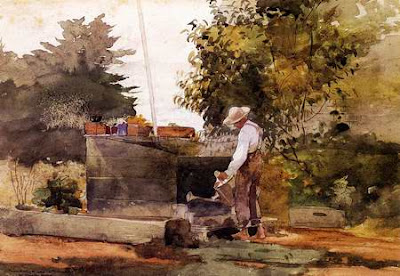Winslow Homer and the Cure for What Ails You (Part 1)
Chaos.
You know the feeling. Lose your car keys when you're late for work and you're guaranteed to go there.
I don't know if the painter Winslow Homer (American 1836 - 1910) ever rode in an automobile, much less if early cars even had keys. But there is no doubt Homer was a sensitive guy- just look at his paintings. My guess is he had his share of mornings when everything was at loose ends.
We have visual art (or music, or dance) because it helps us out of our personal swamps of confusion, alienation, fragmentation. I just ran across this Winslow Homer watercolor. It's a gem. Really good paintings have a remarkable ability to stir us up, excite us a little bit, but also to somehow lay a gentle calming hand on us. Looking at a piece like this Homer painting energizes and relaxes me. And there are no bad side effects.
At first glance Homer's showing us a pretty ordinary garden. Maybe it's his backyard. Homer's eye could look at a seemingly disorganized scene like this and just sense within it the possibilities. On the surface it was chaotic but Homer pulls out of the jumble a sense of hidden connections.
I've taken the liberty to darken down the middle tones in his watercolor (sorry Winslow) to show the overall pattern more easily-
Homer had pushed almost all the tones in his painting away from the pure whites of his paper, except the open sky and the sleeve of the man's shirt. Bushes press in from the left and the right to shape a "keyhole" of sky between the darker branches. And Homer is going to do something special with forms he has spotlighted like this for us. As you look at the man's arm and the lower portions of the sky you sense there's something holding them together. To me they seem to be doing a subtle dance to the same music. Partly it's that they're the only two light forms in a darker world.
But it's more than that (warning- we are about to descend into total art-nerd territory. Casual observers may want to look away right now). My own personal interpretation is Homer secretly crafted a special relationship between the man and that space just to his left. See how as the man's arm leans to the right
a light grey flagpole leans to the left at the same number of degrees off of a true vertical. They gesture upward and outward like an angel's wings in a Renaissance painting.
It gets worse. Start looking at the man's upper back where the suspenders move from this shoulder blade towards the bottom of his ear. Keep going in a straight diagonal line and you find your trajectory lines up perfectly with the bottoms of the dark leaves on the lowest branch at the right of the sky "keyhole."
And keep on moving on this course, pass the flagpole and you find yourself entering the bottom most notch in the dark bush at the left. Homer is posing his figure so that part of his shoulder lines up exactly with a long diagonal line implied by the foliage.
And still worse. Now look at the overall trajectory of the man's arm from shoulder to wrist- especially the left side of his white sleeve. It's marching across the painting in a steep diagonal that leans uphill and to the right.
Compare those two major diagonal lines and you realize they run precisely at 90 degrees to each other. They form a cross shape that's been tilted over a bit on its side. This is NO accident. Either consciously or unconsciously (artists make decisions from the unconscious part of their minds all the time) Homer has put that cross right there in the middle of his composition. He instinctively knew we viewers are attracted by this special relationship of pathways moving at right angles to each other- especially when those pathways are diagonal. (Sometime I'll blog about why I feel this happens).
Maybe one in a hundred viewers is aware of what Homer did in this section of his painting. But ALL of his viewer receive a gentle extra voltage as their eyes scan this passage.





